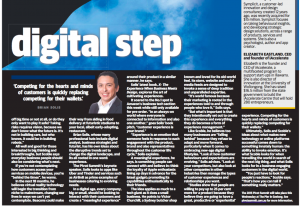

As the host and editorial director for this year’s Pivot Conference, I asked the first wave of registrants what they’re looking to learn leading into the conference. The questions, I imagine, are shared and therefore I am sharing the answers to hopefully hel youp. Here’s part 3 of 3. Follow the links to read part 1 and part 2 .
Q: How should brands think of advocacy in their campaigns?
There are advocates and there are influencers. The idea is to trigger an effect in a one-to-one-to-many process, and additionally in a one-to-many format. Advocates tend to operate en masse, from an emotional state of support and passion, whereas influencers are influential in their ability to impact the masses – but they want to know “what’s in it for them.” Both are important for branding and driving actions and outcomes in social networks.
Even in one-to-one engagement, both advocates and influencers inherently possess the ability to reach many now and over time. Advocacy and influence should be viewed as an always-on strategy for an always-on consumer. It’s a matter of continuum versus campaign – something that I refer to as Hybrid Theory.
Q: What is your next book called?
Well, I haven’t officially announced it yet, but it’s called The End of Business As Usual. I am still working on it in terms of fine-tuning the wording for the sub-title and the description, here’s a sneak peak:
Today’s biggest trends –the mobile web, social media, real-time– are forcing us to rewire the way we think, act, and run our businesses. They have produced a global culture, shrinking the world one tweet at a time. These new tools have created an ever expanding “Egosystem,” in which we all believe our lives deserve 24-hour broadcasts. Now, everyday people are looking to understand what is going on as a result of the social and mobile web. Educators are looking to connect with their students and business leaders are seeking to steer the company toward a new generation of customers. Are we in the age of enlightenment or are we lost in translation? Solis’s The End of Business As Usual explores each layer of this complex world from the government to the everyday consumer, defining this social and business upheaval. http://amzn.to/k0mO7d
Q: What’s the future of social media’s “real-time” nature?
In all honesty, I think social media is what it Is because of it’s real-time nature. We find, we share, we learn. But there’s also the elements of “right-time” and “right place” engagement that helps improve the signal to noise ratio in social media. The interesting thing about social media when we look at it from a social science perspective is that everything is strung together through shared experiences…as they happen. People share everything that moves them and that naturally creates an influx of inbound content. Meaning, that there’s the information that fills our streams and there’s the information that we miss simply because of the constant flow of real-time content.
Real-time will only become more pervasive over time. Users will also become more sophisticated through experience. As they share and discover, the notions of right time and right place will change how people consume and publish, where and when. This will further define the cultures of each social network to help people find and contribute the value that is appreciated by each community of interest as well as their communities at large. In the end, it’s about value and real-time is empowering, but it also is overwhelming without process, structure, and filtration. Since meaningful experiences usually comes down to what you share and consume and with whom you connect, your behavior and how you adapt is defining the future of the real-time web in real time.
Q: What are your thoughts on brand persona? Does this detract from “authenticity”?
There are brands ranging from products to entertainment to services that create a persona to interact with that comes alive in social networks. But there are also those where the brand is eclipsed by the person or people representing the brand in social networks. For example, an individual may define the brand personality based on their mannerisms, words, tenor, etc. This in many cases is unintentional. I once studied the top luxury brands in the world and their voice, persona and character were virtually indistinguishable from one another. They each sounded and acted like an everyday young girl, not catering to the sophisticated or discerning you might envision. This is why creating a brand style guide is so important. If the voice or persona isn’t adding to the experience or reinforcing the brand mystique or brand as it exists outside of social media, your activities might actually be taking away from it.
There is also confusion in social media around whether or not engaging behind a character is transparent and authentic. The answer lies in the relationship the brand seeks to build and what the consumer expects from the experience…think the characters of Mad Men for instance. If a customer buys into the brand as an experience, then the brand’s service becomes paramount to the final success of the relationship.
About Pivot
The Pivot Conference is designed for brands and their agencies and will take place October 17th and 18th in New York. This year’s theme focuses on an important shift in marketing as brands respond to “The Rise of the Social Consumer.”
If you’d like to join us, you can register here. Please use SOLISVIP for a special 20% discount. Contact Mike Edelhart at medelhart@pivotcon.com to inquire about sponsorships.
For more, please read our first report, “Brands Pursue the Social Consumer.”
Image Credit: Shutterstock





i appreciate your perspective on the social consumer. but are you still stuck in the ad paradigm of emotionally charging an experience and hoping the social consumer is confused by by emotion to think this is real knowledge?
This sounds a bit like Frank Luntz to me. Highjacking words like transformative – can Starbucks really be that engaging…will the grey haired senior execs go for it?
Interesting comment. I must ask, is this the first time you’ve visited this blog? I ask because if you’ve read my work over the years, you’d find that it’s quite the opposite. The idea is to not manipulate emotions but to understand where value and opportunity actually reside in order to deliver a more engaging and appreciated experience. Part of the problem with social media is that it’s underestimated. Many brands believe that by simply having conversations or by introducing temporary emotion into the mix, that they can trigger desirable consumer activity. However, what many aren’t thinking about is the long term play. Once a consumer shuts off, which they will, what then?
Balancing a brand persona and staying “authentic” is a tough one. It’s not just in the style and your language but in thousands of micro-decisions you make everyday when communicating. Thanks for writing Brian.